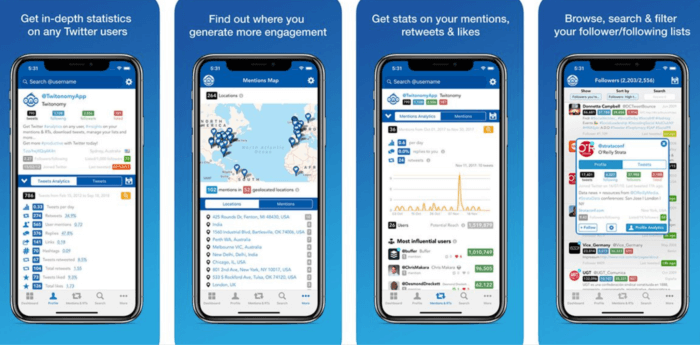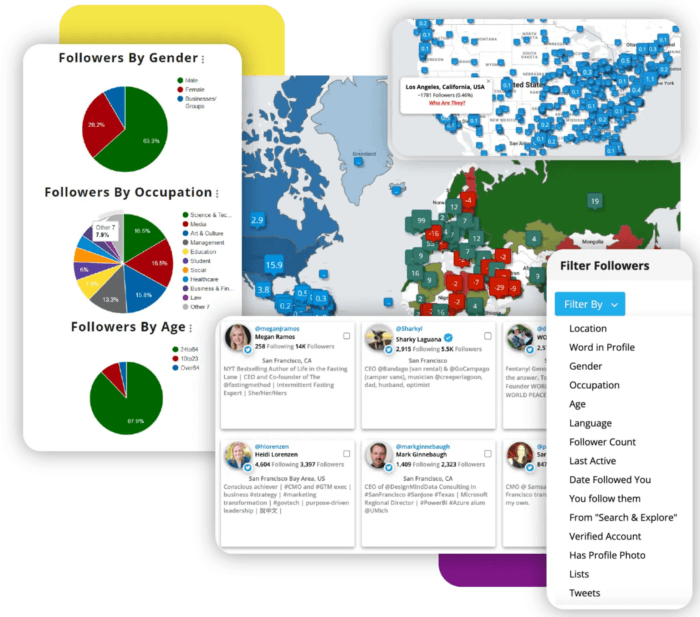Twitter is in a state of flux, with changes coming around every corner. Whether you’re calling it Twitter or by its new name, X, the platform is clearly undergoing a transformation. However, these changes don’t mean that it’s time to abandon ship.
According to our 2023 Social Media Benchmark Report, engagement rates are holding steady on Twitter despite posting frequency being down 20%. With the right Twitter strategy, you can still get high engagement and more followers on the social network.
That’s where Twitter analytics tools come in. We’re big believers in the benefits of testing and reinvesting. In order to make that reinvestment, you need to know what’s working. A Twitter analytics tool can help you crunch the numbers to allow you to build a strategy of what’s getting engagement and forgo what isn’t. Let’s get into what you want out of a Twitter analytics tool and where to find the best ones on the market.
What to Look for in a Twitter Analytics Tool
A good Twitter analytics tool will let you dive into the most important Twitter metrics, like impressions, engagement rate, and hashtag performance. However, it’s not enough to simply have access to these metrics. Twitter analytics software should also display this information in an easy-to-understand way. If you can’t navigate the platform and easily access these metrics, the software won’t help you understand what you need to change or reinvest in.
Analytics is also just one piece of the puzzle when it comes to building your Twitter strategy. You may also want to invest in a platform that includes social listening. Such a tool will monitor who’s talking about you, what they’re talking about, and how they feel about your brand. These social listening metrics can help you get a more complete picture of your Twitter presence.
The Top 10 Best Twitter Analytics Tools
1. Twitter Analytics

How it works: Twitter Analytics is Twitter’s native analytics tool. This page will give you a summary of your Twitter performance over the past 28 days, where you can see your impression count, follower count, engagement rate, and breakdowns of your best-performing tweets from the past month.
Pros: If you’re just starting out with paying attention to your analytics on Twitter, Twitter Analytics can be an excellent place to start, as it’s a free option.
Cons: The data received through Twitter Analytics is limited, both in terms of the time you can look back on and the number of metrics you can see. Moreover, Twitter Analytics is currently undergoing some changes, so the data you see here may not be what you see on Twitter Analytics forever.
2. Rival IQ
 How it works: Rival IQ provides an in-depth dive into your Twitter analytics, providing you with an easy-to-navigate dashboard that shows you metrics for every tweet. Yes, we know we’re recommending our own tool, but we have a good reason. With us, you also get actionable insights, such as when the best time to post is and what hashtags may benefit your Twitter strategy. With Rival IQ’s competitive benchmarking tools, you’ll get information on your biggest competitors to help you learn from what’s working for them and get ahead of other brands in your industry.
How it works: Rival IQ provides an in-depth dive into your Twitter analytics, providing you with an easy-to-navigate dashboard that shows you metrics for every tweet. Yes, we know we’re recommending our own tool, but we have a good reason. With us, you also get actionable insights, such as when the best time to post is and what hashtags may benefit your Twitter strategy. With Rival IQ’s competitive benchmarking tools, you’ll get information on your biggest competitors to help you learn from what’s working for them and get ahead of other brands in your industry.
Pros: Investing in Rival IQ’s social media analytics tool also means getting access to social listening features, including one designed specifically for Twitter, that can help you discover who is talking about you, what they’re saying, and the overall sentiment toward your brand.
Cons: Some users suggest that Rival IQ’s reporting could be more customizable.
3. Emplifi
How it works: Emplifi Unified Analytics pulls your Twitter analytics into one place and gives you insights into how to use the data to update your Twitter strategy. Emplifi prides itself on being able to take complex data and turn it into something easier to understand. You’ll also be able to pull analytics on your competitors to help you learn from them as well.
Pros: Emplifi gives you access to publishing and community management features, allowing you to do all your Twitter work through the platform.
Cons: Some users say that Emplifi sometimes misses information from Twitter and that Twitter analytics are not thorough. Unlocking additional features, like social listening, requires upgrading to a larger package.
4. Keyhole

How it works: Keyhole is a social media analytics and social listening tool that helps you understand your Twitter presence and optimize it with the help of in-depth reporting. Monitor what people are saying about your brand, get real-time data on your ongoing campaigns, keep an eye on competitors, discover your best new influencer, and conduct market research on social media trends all in one place.
Pros: Users say that Keyhole is particularly great for tracking hashtag performance. The platform is also said to be highly easy to navigate.
Cons: Some users suggest that Keyhole’s data isn’t always accurate, making it essential to use additional tools to keep an eye on your Twitter performance.
5. Twitonomy

How it works: Twitonomy is a social media analytics tool solely dedicated to Twitter. Track and get insights into Twitter accounts through customizable reports. Keep an eye on keywords and hashtags to join in the online conversation in the most effective way.
Pros: Twitonomy is ideal for helping you optimize your follower and following lists, allowing you to connect with your ideal customers and cut out time spent on those who will likely not convert into buyers.
Cons: Twitonomy sometimes pulls old tweets into new reports, giving you inaccurate and outdated information.
6. Hootsuite

How it works: Hootsuite is an all-in-one tool that lets you publish content, track its performance, and listen in on the online conversation around your content and brand overall. Hootsuite also takes all that data and helps turn it into actionable insights, such as your best time to post and your best hashtags. You can also keep an eye on your competition through the software’s easy-to-use dashboards.
Pros: Hootsuite works as a one-stop shop for your Twitter needs. Through the application, you can create content, manage your community, and build customizable reports tailored toward the KPIs you want to see.
Cons: Hootsuite only lets you track a limited number of competitors. According to users, the platform sometimes struggles to communicate with Twitter.
7. TweetBinder
How it works: TweetBinder is primarily a hashtag and keyword analytics tool for Twitter. From a keyword or hashtag, the platform can get in-depth information, including tweet volume and sentiment.
Pros: TweetBinder offers both free and paid versions. If you’re a small business just starting out, the free version will likely be sufficient, allowing you to put your budget elsewhere. The Twitter analytics tool also lets you focus on either real-time data or historical reports. With a paid version, you can run unlimited reports.
Cons: TweetBinder pricing depends on how many mentions you want to track per month. Whether you’re a larger corporation that typically gets a lot of mentions or a smaller brand that just happens to go viral, you’re looking at quite a significant increase in cost from businesses that get fewer mentions.
8. Fedica

How it works: Formerly known as Tweepsmap, Fedica is a scheduling, management, and analytics tool. Dive deep into your engagement, helping you learn about your followers and what they want to see. With Fedica’s community analysis and social listening tools, you can connect with those who fit your target audience with ease.
Pros: Fedica does market research for you by offering information on live trending topics to help you optimize your content for the current online conversation. Fedica’s AI-driven analytics is segmented to ensure that you get an in-depth look into different facets of your audience, helping you build a better picture of each of your buyer personas.
Cons: Some users say Fedica isn’t intuitive, and it can take some time for one to learn how to use it.
9. Trendsmap

How it works: Trendsmap dives into historical data on Twitter to help you uncover trends across time. Search for specific keywords, see how trends evolved, and get eye-catching visualizations of metrics around these topics.
Pros: Trendsmap lets you get an in-depth view of specific trends on Twitter, allowing you to learn more about how conversation topics have shifted over time.
Cons: While this Twitter analytics tool used to show you more current data, historical data is all that Trendsmap can access anymore due to Twitter’s backend changes. Data now cuts off at July 2023.
10. Agorapulse
How it works: Agorapulse is an all-in-one tool that helps you create content, monitor your mentions, talk to your community, publish posts, and get reports that allow you to see what’s working and what isn’t in your Twitter strategy. With Agorapulse’s reporting, you’ll get a complete picture of everything from your engagement rates to your return on investment.
Pros: Agorapulse’s reporting gives you valuable insights and also provides you with all the documentation you need to show your stakeholders what you’re working on. Users also say the interface is very user-friendly.
Cons: Some users say Agorapulse’s reporting features lag behind the capabilities of some of the platform’s competitors. This software is also one of the more expensive Twitter analytics tools, which might make it not feasible for smaller businesses.
Start analyzing your Twitter performance with Rival IQ. 
Wrapping Up Twitter Analytics
When you invest in a good Twitter analytics tool, you’re really making an investment in optimizing your Twitter strategy. With the right tool, you can see what’s working with your strategy and remove the things that aren’t. From helping you reach your target audience to allowing you to listen in on what the word is about your business, a Twitter analytics tool can make a world of difference in your Twitter presence.
Looking for tools that’ll help you optimize your social media strategy beyond Twitter? Check out our list of the best social media analytics tools for all major social networks.
